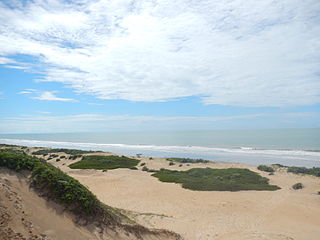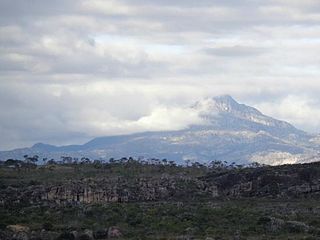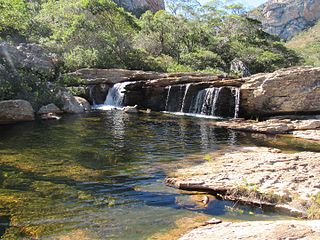History
A Botanical Garden was defined in the area by decree 10.232 of 1932 with the objective of preserving the vegetation and landscape of Belo Horizonte. This would be the first conservation unit in the city and one of the first in the state and the country. However, nothing was done to implement it.
The Baleia State Park was created by decree 28.162 of 6 July 1988. The park was to be implemented by the city in partnership with the state. As of 2010 it had not been opened to the public. The park adjoins the Mata das Baleias (Baleias Forest), owned by the Hospital da Baleia. In 2010 the Hospital da Baleia said it was partnering with the private sector to support adventure tourism in the forest, and establishing partnerships with universities for research. The 2 kilometres (1.2 mi) Solidarity Trail leads from the hospital's headquarters to the 1,400 metres (4,600 ft) Pico Belo Horizonte, also known as Antenna Peak, from which the whole city is visible. The hospital would gain revenue from tourism.
In October 2014 the Public Ministry of Minas Gerais (MPMG) filed an action demanding implementation of the Baleia State Park, naming the State Forestry Institute (IEF) and the Prefecture of Belo Horizonte. The ministry said the area had been protected since 1932 but the park had never existed except on paper. There was no infrastructure, and the park suffered from fires, squatters, deforestation and water pollution. The action required creation of a consultative council for the park and demanded appointment within 30 days of a manager and four park rangers, with vehicles and necessary equipment.

Belo Horizonte is the sixth-largest city in Brazil, with a population around 2.7 million and the third largest metropolitan area with a population of 6 million. It is the 13th-largest city in South America and the 18th-largest in the Americas. The metropolis is anchor to the Belo Horizonte metropolitan area, ranked as the third-most populous metropolitan area in Brazil and the 17th-most populous in the Americas. Belo Horizonte is the capital of the state of Minas Gerais, Brazil's second-most populous state. It is the first planned modern city in Brazil.

Montes Claros is a city located in northern Minas Gerais state, in Brazil. It is located north of the state capital, about 422 km away from it. The population is 413,487 in an area of 3,569 km2 (1,378 sq mi). It was made a seat of a municipality in 1831 and attained city status in 1857.

Nova Lima is a municipality of about 87,000 people, whose downtown is located about 20 kilometers south of Belo Horizonte, the capital of the south-eastern Brazilian state of Minas Gerais. Mining is one of the main economical activities of the city, including the extraction of Iron Ore and Gold. The most famous mine in the city is Morro Velho, a gold mine of 2,700 metres (8,900 ft) depth.

Lagoa Santa is a municipality and region in the state of Minas Gerais, Brazil. It is located 37 km north-northeast from Belo Horizonte and belongs to the mesoregion Metropolitana de Belo Horizonte and to the microregion of Belo Horizonte. In 2020 the estimated population was 65,657.

Pedro Leopoldo is a Brazilian municipality in the state of Minas Gerais. The city is located in the Greater Belo Horizonte region. As of 2020, the estimated population was 94,712. The city is birthplace to prominent medium Chico Xavier and 1970 World Champion and Cruzeiro footballer Dirceu Lopes.
Carste de Lagoa Santa Environmental Protection Area (Portuguese: Área de Proteção Ambiental Carste de Lagoa Santa is a protected area in Minas Gerais, Brazil.
Carmo da Mata Biological Reserve was a state-level biological reserve in Minas Gerais, Brazil.
Acauã Ecological Station (Portuguese: Estação Ecológica Acauã is a state-operated ecological station in the State of Minas Gerais, Brazil. It is a strictly protected area and is closed to the public except for research and environmental education.
Mata dos Ausentes Ecological Station is a state-administered ecological station in Minas Gerais, Brazil.

Serra do Gandarela National Park is a national park in the state of Minas Gerais, Brazil. It protects a mountainous region holding a remnant of Atlantic Forest that is an important source of water for the city of Belo Horizonte.

The Itaúnas State Park is a state park in the state of Espírito Santo, Brazil. It protects the lower reaches of the Itaúnas River and a strip of marshes, dunes and beaches along the Atlantic coast of the north of the state.

The Biribiri State Park is a state park in the state of Minas Gerais, Brazil. It protects a mountainous region of cerrado. The park contains an abandoned village, once home to workers in a textile factory, which is now a tourist attraction.

The Sumidouro State Park is a state park in the state of Minas Gerais, Brazil. The remains of the first human inhabitants of Brazil were found in the park area in the early 19th century, along with bones of now-extinct megafauna. The main attraction is the Gruta da Lapinha, a large limestone cave.

The Pico do Itambé State Park is a state park in the state of Minas Gerais, Brazil. It protects one of the higher peaks in the state.

The Serra do Rola-Moça State Park is a state park in the state of Minas Gerais, Brazil. It protects a rugged area in the transition zone between cerrado and Atlantic Forest. Springs in the park are important to the water supply of the state capital, Belo Horizonte.

The Grão Mogol State Park is a state park in the state of Minas Gerais, Brazil. It protects an area of high, mountainous terrain with cerrado vegetation, important as a source of water in a region with a dry climate.

The Serra Negra State Park Portuguese: Parque Estadual da Serra Negra is a state park in the state of Minas Gerais, Brazil. It protects a mountainous area in the Atlantic Forest biome, an important source of water in a dry region, and a potential source of tourism revenue in an area with many social problems.

The Rio Preto State Park is a state park in the state of Minas Gerais, Brazil. It protects a mountainous area of cerrado vegetation that is home to various endemic, rare or endangered species. Trails provide environmental interpretation, and lead to lookouts that give panoramic views, to rivers and waterfalls, and to archaeological sites with rock paintings.

The Serra Nova State Park Portuguese: Parque Estadual de Serra Nova is a state park in the state of Minas Gerais, Brazil. It protects an area of rugged terrain with considerable diversity of flora and fauna.

The Rio Doce State Park is a state park in the state of Minas Gerais, Brazil. It protects a large remnant of Atlantic Forest, and includes a system of lagoons rich in species of native fish.
















